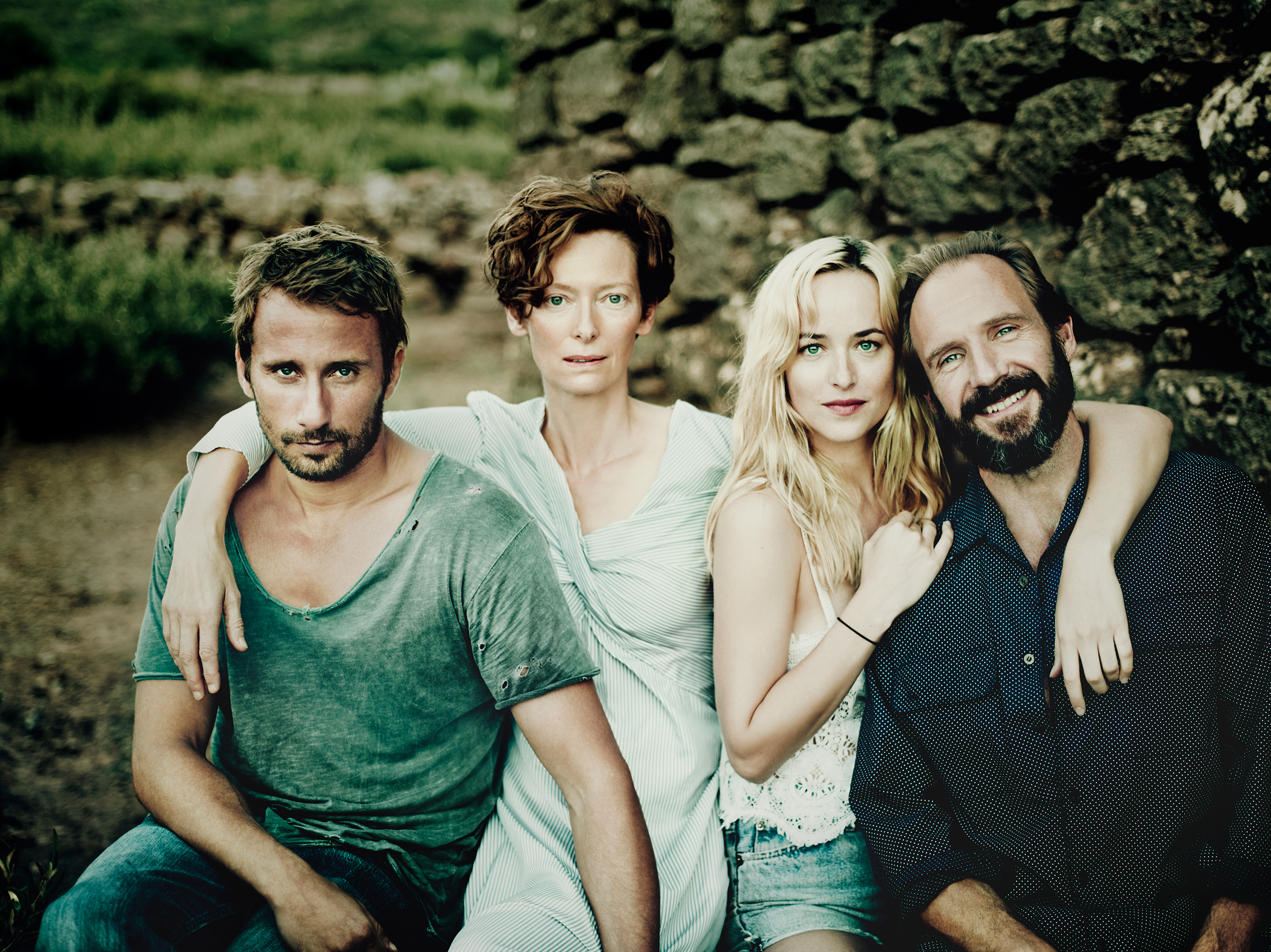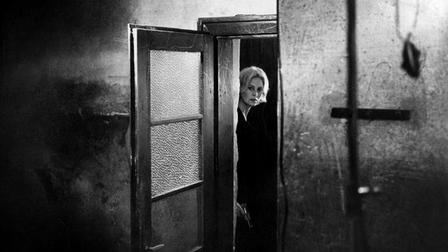
An astute, merciless, Pinterequse duel to the death. Courtesy Fox Searchlight
Vanity Fair only profiles four types of people:
1) Someone young, glossy, gorgeous, mad fuckable, talented, lucky and on the rise. She wouldn’t touch you with a ten-foot pole and her week beats your year. *
2) Someone in the prime of life and career. A gleaming armor of success gilds his wealth, beauty, fuckability and celebrity. His weekend beats your year.
3) Someone in their golden years who either remained successful, gorgeous, fuckable and famous or who lost it all. Whether reminiscing from their cashmere couch or scarfing cat food with their remaining Tiffany spoon, his or her memories of a single glorious night beat any ten years you can barely recall.
4) Any of the above who get their comeuppance/martyrdom by dying/getting killed.**
A Bigger Splash features all four types. And on first viewing, proves as irritating as any Vanity Fair profile. There’s something profoundly irksome about “all this useless beauty,” glamor and privilege. ***
Yet the very aspects of Splash that seemed so off-putting prove to the most fascinating and sustaining. First time round, the mostly naked Tilda Swinton, Dakota Johnson, Ralph Fiennes and Matthias Schoenaerts prove too distracting. They’re so darn purty! And worldly! And chic! It’s hard to focus on subtext when Swinton does one of her patented, languorous angel/demon/alien pre-coital stretches. Providing more distraction is an unending parade of movie star full-frontal. Ralph Fiennes dick? A gynecological close-up of Swinton from behind? Schoenaerts’ scrotum? All you might want and more. Johnson plays a 17-year old and so appears only naked from head to toe.
Schoenaerts and Swinton are in love. They’re hiding out up in glamly understated villa on the barren, serene island of Pantelleria. Swinton’s former flame and Schoenaerts’ former pal Fiennes shows up, with his maybe-daughter Johnson in tow. Swinton’s a rock star recovering from surgery. In flashbacks of her onstage, she’s a semi-Bowie figure and Swinton – who’s rumored to be considering playing Bowie in a biopic – makes you believe. She makes you believe by never singing onstage, a rare moment of restraint from director Luca Guadagnino. His previous film, the camp, risible I Am Love, suggests that restraint is not in his quiver.
Fiennes is a guy we all know: nonstop energy, unquenchable sex drive, outdrinks/drugs everyone and wakes up un-hung-over and ready to go go go! Produces the Stones and knows a rundown house on a back alley where an Italian granny-lady makes the world’s best ricotta. You know a guy like that, right? Neither do I.
 "I'm not fucking my daughter!" Courtesy Fox Searchlight
"I'm not fucking my daughter!" Courtesy Fox Searchlight
It’s the performance of the year and of Fiennes’ career. From Schindler’s List to In Bruges, Fiennes played a bubbling volcano, a seething mass of repression. Here, the lava spews. He’s a conniving prick and totally upfront about it. Fiennes’ frantic, scampering dance around the villa gives the Stones’ Emotional Rescue more credit than it deserves, but should win Fiennes an Oscar.
He incarnates this universe of hard-earned license, individuality and id. Did these folks get world famous by being nice? Or putting anyone else first? This is a nest of lovely vipers. I mistook Splash for Bertolucci lite: a stylish, empty wallowing in the haut lifestyle – like Stealing Beauty. It turns out to be something much richer: an astute, merciless Pinteresque duel to the death.
Over love.
Though Bertolucci’s style informs every frame, the characters evoke Chabrol and even Hitchcock. The suspense derives not from the action, but the conversation. You have to pay attention. This sophisticated bunch lives for a multi-layered retort. They hide their venom in verbal cookies full of arsenic; indicating what they mean, never saying it outright. The truth hides in every deceitful word or ambiguous shrug as the non-stop camera whirls to the next exquisite landscape, naked ass or gyrating poolside supermodel. It’s compelling and at times exhausting, but irresistible.
Everyone’s feelings for everyone are complex, and, as Keith Richards told a judge fifty years ago, not concerned with petty morals. Johnson’s constantly cruel – always seeking the most furious response. Swinton’s superstardom’s brought her compassion. When Johnson attacks, Swinton responds with truly moving kindness. At some point, everyone behaves exactly as you thought they never would.
Splash is a remake of the 1969 decadent French nugget la Piscine.**** By ‘69 standards, Piscine’s as explicit and steamy as Splash, with va-va-voomy Romy Schneider languidly strolling naked by the pool or lolling around in bed. There’s one big difference: Alain Delon plays Schoenaerts’ role. Swinton’s nursing Schoenearts as he recovers from a half-hearted suicide attempt. Given Schoenearts’ sensitive reticence, you buy it. But Delon? He’s indestructible. So why title this version with a meaningless Hockney reference? Please see “camp, risible,” above.
The plot slowly emerges through the mists of glam. Fiennes came to win Swinton back. He brought his daughter as a honey-trap for Schoenaerts. That’s how these people roll. Then playtime ends and something terrible happens.
Guadagnino indulges in a deflating Hitichcockian conceit: a dim, fawning cop bedazzled by stardom. It’s the only point Guadagnino pounds with a hammer: the blind love of silly mortals lets the gods soar free. In the final shot, the gods realize they’ve escaped. They did horrible things. They learned unexpected lessons about their own corruption. But their luck held and they love one another all the more. A final, bitter triumphant smile makes all the plot and character elements suddenly cascade into order, like film of a collapsing Lego structure run in reverse. It may take that smile, and the clarity it brings, to realize this is the best film of the year. It only took me seeing it twice.
 Uneasy even in mud. Courtesy Fox Searchlight
Uneasy even in mud. Courtesy Fox Searchlight
I Am Love was Guadagnino aping Visconti. He sought grandeur but lacked Visconti’s gravitas – who doesn’t? Splash is Guadagnino as Antonioni, finding profundity in the jet set with all their angsty solipsism. For Antonioni, alienation meant stillness. His characters, even when running, so vested in every gesture they seemed in slow motion. Living with their existential pain took so much effort. Not these folks. You can feel them fidget, vibrating with unease. That unease lingers long after the movie ends. Not the amazing clothes or the celestial light or the perverse bonding. What sticks is everyone’s unspoken terror that – despite all they’ve earned and been given – they’re flying too close to the sun.
* Lou Reed from the liner notes to Metal Music Machine
** Thanks Sarahjane Blum
*** Elvis Costello
****Amazon Prime https://www.amazon.com/Piscine-English-Subtitled-Alain-Delon/dp/B009ASU1JI/ref=sr_1_1?ie=UTF8&qid=1465596067&sr=8-1&keywords=la+piscine
 Tuesday, March 21, 2023 at 03:55PM
Tuesday, March 21, 2023 at 03:55PM 
 Antonioni,
Antonioni,  Michele Morgan,
Michele Morgan,  Monica Vitti,
Monica Vitti,  Robert Hossein
Robert Hossein 




